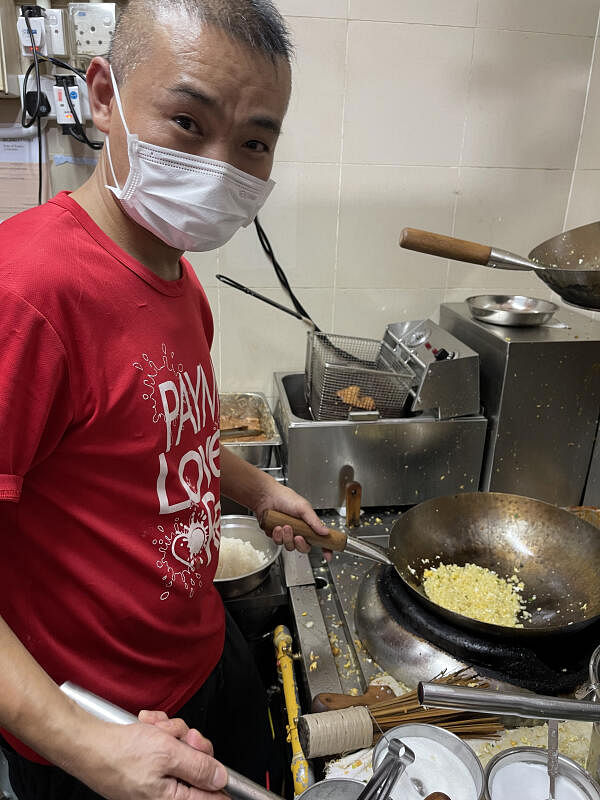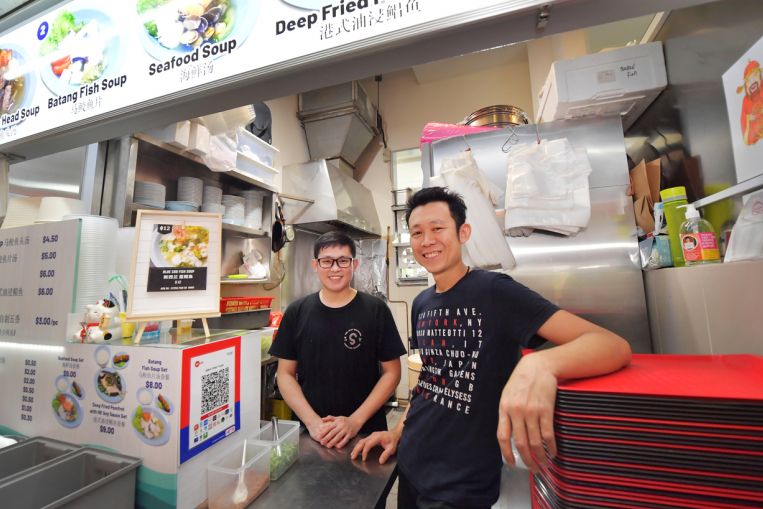SINGAPORE – It is not uncommon for restaurant chefs to start their own business. But those who trade their chef whites for a hawker’s apron have been few and far between.
Chefs known to have made the switch include former Les Amis sous chef Xavier Neo, who now runs the Hokkien Man Hokkien Mee stall in Toa Payoh.
In the last few months, however, more restaurant chefs have set up hawker stalls – prodded by the pandemic pummelling the food-and-beverage industry.
Among them is former Shang Palace dim sum chef Kerene Cheng, who has been selling Hong Kong-style cheong fun at an industrial park canteen in Ang Mo Kio since April. Customers reportedly queued for up to two hours for her food before the current dine-in ban.
Since then, at least four other former restaurant chefs have also started hawker stalls.
Kek Wan Fong, former head chef at upscale seafood restaurant Naked Finn, opened a fish soup stall in Tiong Bahru with Gui Jin Keng, who helmed the kitchen at Asian fusion restaurant Perch.
Dim sum chef Thoo Chang Wei left Chinese restaurant chain Peach Garden to set up a chee cheong fun stall in Bedok.
Wang Jingjun, a former chef at Taiwanese chain Din Tai Fung, now dishes out fried rice at the Beo Crescent food centre.
Qing Feng Yuan
Where: 02-49 Tiong Bahru Market and Food Centre, 30 Seng Poh Road
Open: 9am to 5pm (Tuesdays to Sundays), closed on Mondays
The ongoing Covid-19 clusters and tightened measures have dealt a double whammy to Kek Wan Fong and Gui Jin Keng, who opened their fish soup stall in June.
Tiong Bahru Market and Hawker Centre, where the stall is located, has seen a sharp drop in footfall over the past two weeks as people shy away from wet markets and food centres because of the spiraling Covid-19 cases linked to Jurong Fishery Port.
The duo are also affected by the diminishing supply of batang fish because of the fishery port’s closure.
Since the current dine-in ban kicked in, their takings have plunged by 40 per cent.
While they have registered with delivery platforms, they decided not to use them to prioritise walk-in customers.
All things considered, the former restaurant chefs say they are doing “pretty okay”.
They grew up in Muar, a town in Johor, but got to know each other in Singapore while working at Equinox restaurant – now known as Skai – in Swissotel The Stamford during the late 2000s.
They also worked at Osia in Resorts World Sentosa, but at different times.
Before starting their stall, Kek, 39, was the head chef of Naked Finn in Gillman Barracks for nine years, while Gui, 32, helmed the kitchen at Perch restaurant in Jewel Changi Airport.
Both men, now permanent residents, had long harboured the idea of starting their own business and decided to do it together a year ago.
They chose to start a hawker stall instead of a restaurant because of financial constraints.
“Last year was also when Singapore hawker culture was added to the Unesco list of intangible cultural heritage,” Kek adds.
“I thought it was good for young people to join the hawker industry.”
They decided to sell fish soup because it is “a traditional dish representative of Singapore”, even though they are trained in Western cooking.
On the menu are items like batang fish soup ($5), seafood soup ($6), blue cod soup ($12) and ngoh hiang ($3).
Though they miss working with a team, Kek says they “work well together”.
He does most of the cooking, while his partner takes orders, collects money and occasionally steps behind the stove.
They share the preparation and cleaning up work.
Kek appreciates the “kampung spirit” at the hawker centre.
“As first-time hawkers, we got a lot of tips from our neighbours,” he says.
“For example, we realised we could not cook the same way we did in restaurants, which requires a lot of steps. We learnt to cut them down.”
Another thing they had to sacrifice was a steady pay cheque.
In the first month, Kek, who is married with two children aged seven and four, says he took home 40 per cent less than his restaurant pay – after tendering $5,223 to rent the stall each month.
But he thinks the sum is worth it because of the location. He is prepared to grit his teeth for the next three years, after which rentals will revert to lower market rates.
In the meantime, it is elbow grease all the way.
The duo are at the stall just after 6am and leave at 8pm. In the first month, they took only two days off.
Now, they are open daily, except on Mondays. They also open half an hour later and close 90 minutes earlier.
Both say they have no regrets.
Gui, who is single, says: “I work harder, but it’s our own business and I get more satisfaction from it. I’m happy when I see customers returning.”
Chef Wei HK Cheong Fun

Where: 01-633, Block 209 New Upper Changi Road
Open: 7am to 9pm daily
Chee cheong fun, or steamed rice rolls, have been Thoo Chang Wei’s favourite food since childhood. And it had always been his ambition to make a living selling it.
That was why he left school at the age of 18 to work at Min Kok restaurant in his home town of Seremban in Malaysia.
Starting as a kitchen helper, he mastered the dish so well that he was soon running the cheong fun station by himself.
He came to Singapore in 2010 to join Peach Garden as a dim sum chef and worked at the chain’s outlets in OCBC Centre, Hotel Miramar and Thomson Plaza.
The 36-year-old permanent resident’s dream to be his own boss came true when he opened a stall at a coffee shop in Bedok Town Centre earlier this month.
He sells Hong Kong-style cheong fun that is prepared on the spot, with fillings like char siew ($4), mushrooms ($4) and prawns ($5).
It was the pandemic that pushed him to start his own business.
“Last year, the restaurant was open only half the week, so I had time to think about what I wanted to do next,” he recalls, adding that he started looking for a location at the beginning of this year.
Thoo, who is married with two children aged five and three, does the cooking himself. He has not yet taken a day off, even though he has two full-time and four part-time workers.
His hours are also longer – “by about 50 per cent” – than at his last job. But his income has also jumped by the same percentage – thanks to a steady “queue from 7am to 8pm”, he chirps.
In fact, his business has improved after the dine-in ban as more people learnt about his stall.
He now sells about 800 portions of cheong fun for takeaway a day, compared with 700 two weeks ago. He does not offer delivery as he can barely cope.
Chef Wang Fried Rice

Where: 01-71, Beo Crescent Market & Food Centre, 38A Beo Crescent
Open: 10am to 8pm daily
When the revenue of Taiwanese chain Din Tai Fung took a dive during the circuit breaker last year, Wang Jingjun, who was working as a chef there, decided to call it a day.
He went to work for a friend who owns a Northern Chinese eatery. In May this year, he started his own stall selling fried rice in Beo Crescent.
On the menu are dishes like pork chop fried rice and shrimp fried rice ($6.50), as well as an abalone fried rice ($10). Wang also offers spicy versions of the dishes.
Armed with a chef’s diploma from China, the Shandong native came here in 2003 at the age of 26 to work at Soup Restaurant, where he remained for seven years.
But Wang, 44, who is now a Singapore citizen and married with three children aged 18, nine and seven, says it is not in his nature to be a salaried worker.
“I like the freedom of doing what I want and it gives me a sense of achievement,” he says.
After Soup Restaurant, he started a stall selling claypot rice, but gave it up two years later because of health problems.
After he recovered, he worked in restaurants under the TungLok and Paradise groups. He was also with Shang Palace and The Line at Shangri-La hotel before joining Din Tai Fung for about a year.
He says his stall’s offerings are not rip-offs of Din Tai Fung’s, where fried rice is one of the popular dishes. Instead, his menu is culled from his own experiences.
“Fried rice is a very common dish,” he points out. “The spicy flavours, for example, came from what I learnt at Shang Palace.”
His business has not been affected by the no-dining-in rule, he adds.
“Fried rice works well for takeaway. Even when dining in was allowed, I had many takeaway orders.”
While he has signed up with delivery platforms, he has not used them because commissions go up to 30 per cent.
“I would then have to pass the costs to my customers, which I don’t want to,” he says













































